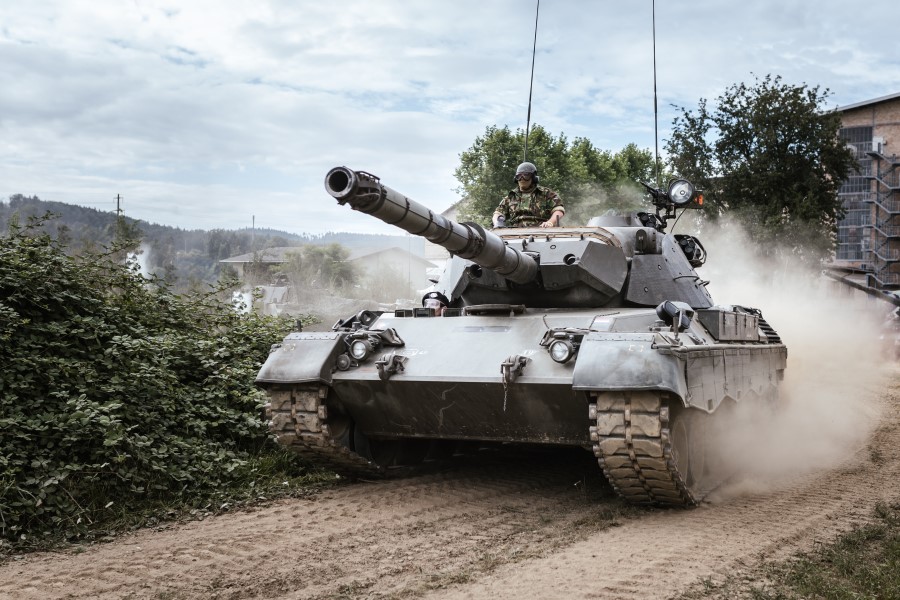The relationship between Europe and Russia is regarded as being at its worst since the end of the Cold War. Russia has ten of thousands of troops massed on the border of European countries. Europe, in return, is increasing its military presence in the east. Many fear a Russian attack. Although most expect a Russian assault if it does come to be smaller in scale, is an all-out invasion of Europe by Russia possible? And if Russia did invade, could it actually take over Europe?
Russia could not take over Europe. The Russian armed forces are not strong enough to conquer the entire continent. A full Russian invasion of Europe is also extremely unlikely. There is a chance of a localized conflict between European countries and Russia, but there is no chance of a Russian takeover of Europe.
Now we’ve had an overview, let’s look at the details and explore why Russia could not take over Europe…
Is Russia’s Military Stronger Than Europe’s?
Russia has one of the largest and most powerful armies in the world. The Russian armed forces are also going through a period of modernization, meaning new military technology is being developed and deployed. Russia’s army may be huge, and increasingly more advanced, but does it have the capabilities needed to invade Europe, and occupy it?
Russia’s army is not strong enough to conquer all of Europe. Russia could also not defeat a combined army of every EU country.
So, that’s the answer, right? Well… maybe, let’s go into some detail…
First, if we’re assessing if Russia has the military strength to take over Europe, let’s define what we mean by Europe. The two easiest definitions are the European Union – the countries formally in the EU political block, and continental Europe, as in all the countries on the land mass of Europe. This is key because the military strength of both varies greatly. Here’s a comparison:
| Country | Number of Active-Duty Soldiers | Number of Reservists | Number of Main Battle Tanks | Number of Combat Aircraft | Number of Warships |
| Russia | 1,015.000 | 2,000,000 | 1,200* | 950 | 352 |
| Europe | 1,855,810 | 2,687,530 | 7,711 | 2,554 | 244 |
| EU | 1,483,710 | 1,178,580 | 4,677 | 2,066 | 210 |
All data from Wikipedia
*It is reported that Russia has up to 12,000 tanks in reserve. We’ve used the current estimate for battle ready tanks.
When speaking of continental Europe, we’re using the UN definition, including a total of 44 countries.
Simply by looking at Russia’s military strength against continental Europe’s, we can see that Russia would struggle to win a war if every nation in Europe allied against them. Including reservists, Europe would have almost a million more soldiers. They would also have over six times the number of tanks and twice a number of combat aircraft. Just the air superiority a joint-European force would have makes Russia taking over Europe nearly impossible. An all-European navy would also outnumber the Russian fleet.
So, it seems that if every nation in Europe resisted a Russian invasion then Russia would probably fail to take over Europe. But all this is an incredibly unlikely scenario. Firstly, the 44 nations on the UN’s list of European countries includes nations that would likely ally with Russia, such as Belarus. It also includes countries that would likely remain neutral in an all-out war between Europe and Russia. With that said, let’s take a look at the data if Russia only invaded the EU.
On the ground, an all-EU army would be more evenly matched against Russia. However, they would still have nearly four times the number of tanks, twice the number of combat aircraft. Simply in-terms of military strength, it is unlikely Russia could take over the European Union.
Another factor we need to consider when assessing if Russia could take over Europe militarily is that many countries in Europe are part of NATO. This would mean the US, Canada and Turkey would likely also join a war if Russia invaded.
| Country | Number of Active-Duty Soldiers | Number of Reservists | Number of Main Battle Tanks | Number of Combat Aircraft | Number of Warships |
| Russia | 1,015.000 | 2,000,000 | 1,200 | 950 | 352 |
| NATO | 3,261,760 | 2,106,850 | 14,971 | 6071 | 503 |
All data from Wikipedia
As the above table shows, NATO’s military strength is far superior to that of Russia. It would be almost impossible for Russia to conquer Europe if it invaded a NATO country. Any NATO country attacked would trigger NATO’s Article 5 – the mutual defiance agreement, and this would pull most countries in Europe, as well as the US, Canada and Turkey into a war to defend Europe.

Why Would Russia Invade Europe?
An attempt by Russia to take over the whole of Europe is extremely unlikely. Although tensions are high between the West and Russia, and there is a possibility of Russian incursions into eastern European countries, an attempt to invade and conquer the entire continent is simply not going to happen.
Even a Russian attack on a small NATO member, such one of the Baltic states, is highly improbable as it would cause a wider conflict that Russia would likely lose. With that said, let’s look at unlikely scenarios that could lead Russia to attempt an invasion of Europe. These include:
- Russian expansionism
- Limit Russia’s strategic weaknesses
- Prevent NATO expansion
- Attempt to reconquer territory
- An attack on Russia
Let’s break these down…
Russian Expansionism
The main population center of Russia is strategically weak. Major cities such as Moscow and St Petersburg have little natural defenses, such as rivers or mountains. The European Plain means that there are thousands of miles around Russia’s heartlands across which armies can easily move. Therefore, historically, Russia has also sought strategic depth as its major defense. This is a main reason why control of countries such as Ukraine and Belarus has been vital for Russia.
Limit Russia’s Strategic Weaknesses
One reason why Russia could possibly invade Europe would be to control neighboring countries and increase its strategic depth. Russia cannot afford for countries too close to its population centers to be controlled by its enemies. Russia aims to ensure friendly regimes in countries such as Belarus and Ukraine. It is conceivable that Russia uses force to ensure this, as it sees it as key to its defense. However, a Russian attack on its neighbors would almost certainly not result in them launching a wider European invasion or trying to conquer the continent.
Prevent NATO Expansion
Since the fall of the Soviet Union, Russia has seen NATO expand into eastern Europe and encroach towards its border. Russia sees this as a threat. The Baltic states are already NATO members, as is Turkey, but Russia could draw a line at Ukraine or Finland joining the block. If diplomatic relations broke-down and tensions rose, it is conceivable Russia could begin a war in Europe over the issue.
A war between Russia and Europe over NATO expansion would likely be contained to eastern Europe. It is extremely unlikely that Russia would attempt to take over Europe in a war resulting from NATO expansionism.
Attempt to Reconquer Territory
Another, albeit also unlikely scenario, would be that Russia tried to take over eastern Europe as part of a neo-Soviet agenda. If a leader in Russia came to power who advocated for regaining former Russian territories, such as the Baltic states or Ukraine that used to be part of the Soviet Union and Russian Empire, and was willing to use force if necessary, then it could be conceivable that Russia invades part of Europe.
Although the rise of a Russian leader whose objectives where to regain former Soviet territories is not wholly improbable, the likelihood of them using force to do so is extremely unlikely.
An Attack on Russia
The only other conceivable scenario where Russia invades Europe is part of a wider conflict, perhaps following an aggressive attack on Russia. This has happened in the past – most notably following the German invasion of World War Two, where Germany’s attack on Russia resulted in them being pushed back and eventually occupied. However, the current political context in Europe and America means this will almost certainly not happen in the future.
What Would A Russian Invasion of Europe Look Like?
Now, we’ve pretty clearly established that Russia does not have the military strength to take over the whole of Europe, and that any full-scale invasion is very very unlikely. But, with that said, the future of Europe is uncertain and tensions with Russia are currently at their highest since the Cold War. So, what would a Russian attempt to conquer Europe actually look like? And what would likely happen?
A Russian invasion of Europe would result in an enormous war. Almost every country in Europe would resist a Russian invasion. Also, as most countries in Europe are members of NATO, a Russian invasion of Europe would draw the United States and Canada into the war.
…with that said, lets look a little deeper…
There are really three ways a Russian invasion of Europe would go. The first would be a full-scale invasion with the aim to conquer and occupy the continent. The second would also be a large war where Russia aimed to defeat Europe, but not to occupy it. The third is a smaller, probably shorter, war limited only to European countries neighboring Russia. Let’s quickly see what each one of these scenarios might look like…
The first scenario of attempted Russian takeover of Europe is a full-scale invasion to conquer Europe. This would involve enormous amounts of Russian troops – potentially almost the entire Russian armed forces, attacking Europe’s eastern flank. It would likely be a multi-pronged attacked – through the Baltics, directly towards Poland and south through Ukraine. Huge numbers of people would be killed on both sides, including civilians. Millions of refugees would begin to pour West to flee the fighting.
An attempt by Russia to occupy Europe for any length of time would result in further death and destruction. The populations of European countries would resist, and likely outside powers would join the conflict in order to liberate Europe. As we have discussed, Russia would almost certainly fail to defeat a joint European army, so it would also have to contend with the remaining European armies continuing the fight.
A Russian invasion of Europe with the aim of defeating the major European powers before retreating would likely play-out similar to an attempt to occupy the continent. A huge Russian invasion would be followed by an enormous war. Hundreds of thousands, if not millions, would die and towns and cities would be levelled. Millions of refugees would be created.
In this scenario, if Russian forces could defeat a joint-European army, they would likely be able to return to Russia and set-up defensive barriers, fortifying their lines before a retaliatory attack by Europe could take place. If they failed to knock-out major military powers such as Germany, France, Poland and the UK, these countries would likely rally an invasion of Russia.
The final, and potentially more likely scenario is a small Russian incursion into one of its eastern European neighbors. Pro-Russian separatists in Ukraine already receive Russian backing and the country annexed the Crimean peninsula in 2014. A similar attempt by Russia to take over part of another European country could escalate into a major conflict, especially if NATO members such as Estonia, Latvia or Lithuania were attacked. However, a Russian attempt to takeover further parts of Ukraine, or another European country, could likely see no response from Europe at all…


